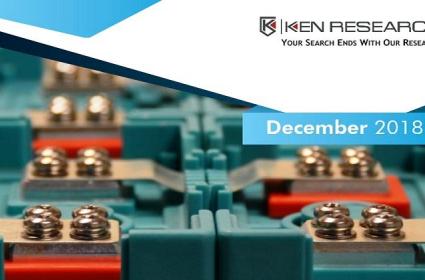India Lithium Ion Cell and Battery Market Outlook to 2023: Ken Research

The report titled “India Lithium Ion Cell and Battery Market Outlook to 2023 - by Type of Battery (LFP, NMC, LCO, MCA and Others), By Application (Consumer Appliances, Telecom Towers and Services, Industrial Application, Automotive and Others) and By Power Capacity” provides a comprehensive analysis of the Lithium Ion Cell and Battery market in India. The report focuses on the Type of Battery, Area of Application and Power capacity of the batteries. The report also covers Investment Model, SWOT Analysis, Trends and Development, Issues and Challenges, Competition Scenario, Decision making process and the Future outlook of the Lithium Ion Cell and Battery Market.
Market Overview
The lithium ion battery market in India gained popularity in the year FY’ 2014 due to sharp rise in demand from the telecom providers in the country, while consumer appliances have been largely dependent on these batteries. The main boom in the market came from increased use by the telecom sector for telecom grids in the country. Reliance Jio telecommunications have been amongst the first few to use lithium ion batteries in their telecom grids and being characterized as green towers in the country.
Market Stage: The import driven India Lithium Ion Cell and Battery Market is at its nascent stage. The companies have just started making footprints in India, and are showing great future potential. Currently, the market is categorized as an assembling market where lithium ion cells are imported and lithium ion batteries are assembled through software and hardware BMS.
Market Segmentation
By Type of Battery
The Lithium Iron Phosphate is the leading segment. It is used in telecom, laptops, digital cameras and wearable products. It offers long cycle life and has a good safe record but exhibits higher self-discharge.
The Lithium Nickel Manganese Cobalt (Li-NMC) contributes a fair share to the industry. It is used for power tools, medical instruments, electric power trains, electric vehicles and other industrial applications. It is capable of high charge and discharge currents but has low specific energy and modest service life.
Lithium Cobalt Oxide (LCO) batteries are mainly used in cell phones, laptops, digital cameras and wearable products. Most companies producing portable electronics prefer using LCO based cells. Lithium Cobalt Oxide batteries has high specific energy with moderate load capabilities and modest service life.
Lithium Nickel Cobalt Aluminum Oxide (NCA) batteries contribute the least. It is used in medical devices, industrial applications, electric power trains and others. Currently, the lithium ion batteries based on NCA are not so widely used in India, but are gaining significant popularity and expected to gain a considerable market share in the future.
By Area of Application
Laptops and tablets, mobile phones, power banks, drone, small household use power tools and UPS (consumer electronics) are the major segments using li-ion batteries in India. The demand for lithium ion batteries in India majorly comes from the push from telecom sector to power telecom towers and other services in the country. The lithium-ion batteries have more than double the life of traditional lead-acid batteries and are helping providers cut costs to store each unit of electricity. Application Li-ion batteries are now being used instead of conventional batteries in larger industrial application including UPS and energy storage systems. The shift to lithium ion batteries is due to the technological capabilities and also because of their customizable property where in the number of cells in the battery can be adjusted based on the energy requirement. Automotive sector is the sector with the highest potential to grow and outweigh all other sectors in terms of lithium ion battery usage, though currently has the lowest share. The increased initiatives taken up by the government and growing public awareness about pollution, electric vehicle segment is expected to pick up pace in the future.
Competitive Landscape
Competition in the Lithium Ion market is intense with increasing imports from China, and assembling of cells into packs in India. While some firms are only trading in battery packs and cells imported from abroad, others have been creating battery modules from cells they import to be sold in the domestic market. Companies compete on the basis of configuration of battery packs, their durability, quality, recharge cycle and application. The big players in the industry target the end users directly usually avoiding mediators such as such dealers, while other small businesses and pack assembly units deal with distributors and dealers.
Future Outlook
India Lithium Ion Cell and Battery Market are expected to grow in the future at a CAGR of 36.3% driven by increased use of lithium ion battery in electric vehicles, rise in public awareness to reduce carbon emissions, government plans and actions to bring in sale of all electric vehicles by 2030. Development of lithium ion batteries for both implantable and non implantable medical devices will drive the future supply. Devices such as ventilators, infusion pumps, dialysis systems and anesthesia machines will be the major users of lithium ion battery backups.
Also Read: China Lithium Ion Battery Market Outlook to 2022: Ken Research














